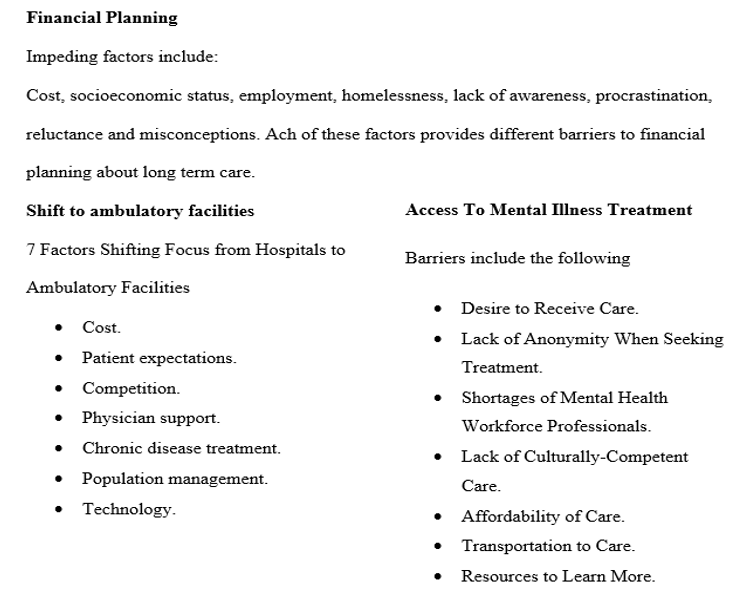Given the increasing longevity of Americans and the costs of providing long-term care, anticipation
Assignment Description:
Complete ALL of the bullet points below:
- Given the increasing longevity of Americans and the costs of providing long-term care, anticipation of the costs should be a major element of every family’s financial planning. Current information suggests however, that very few families or individuals give this consideration. What factors might impede this advance planning? What measures might be effective in raising awareness among Americans about this important matter?
- Identify the major factors that have resulted in the shift in utilization from inpatient hospitalization to ambulatory care services. What are the implications of this shift for hospitals, consumers, and the health care delivery system as a whole?
- The recipients of mental health services in the US represent only a small percentage of those in need of services. Discuss the factors that impede access to mental illness treatment.
- Include a screenshot of your note taking from your reading this week.
Please submit one APA formatted paper between 1000 – 1500 words, not including the title and reference page. The assignment should have a minimum of two (2) scholarly sources, in addition to the textbook.
M3 Assignment UMBO – 2
M3 Assignment PLG – 4, 8
M3 Assignment CLO – 5, 7
The following specifications are required for this assignment:
- Length: 1000-1500 words
- Structure: Include a title page and reference page in APA style. These do not count towards the minimal word amount for this assignment.
- References: Use the appropriate APA style in-text citations and references for all resources utilized to answer the questions. Include at least two (2) scholarly sources to support your claims.
- Format: Save your assignment as a Microsoft Word document (.doc or .docx).
- File Name: Name your saved file according to your first initial, last name, and the module number (for example, “RHall Module 1.docx”)
Expert Answer and Explanation
Caring for Patients
The healthcare sector comprises patients from different walks of life. Care providers must understand the nature of different patients ascribed to the healthcare processes. Patients on either hand ought to be prepared in the event of medical emergencies and other medical care practices (Sultz & Young, 2017). This paper will focus on the different issues that might affect access and quality of medical care for patients.
What factors might impede this advance planning? What measures might be effective in raising awareness among Americans about this important matter?
Despite the healthcare sector is an integral part of many families around the world, limited to no financial allocations are put toward safeguarding the future of care. Various factors can impede financial planning associated with the long-term care of families. To begin with, long-term care can be expensive too and those that have insurance covers need to part with a significant amount of money for a specified period (Van Houtven et al., 2020). For many families, affording to set aside finances to cover healthcare needs can be a major challenge.
Low-income families may find it difficult to meet the financial needs of their everyday life and also plan for long-term care. Unemployment is a major issue since it increases overdependence on the family setup. Alternatively, Families may avoid discussing long-term care costs because it can be a sensitive and uncomfortable topic, especially when discussing it with aging parents (Van Houtven et al., 2020). These factors inhibit the ability of the family to afford the financial planning for long-term care.
The other aspect that impedes financial planning for families is a lack of awareness. The majority of the community members are not aware of the high costs of long-term care and may not fully understand the need to plan for it. Individuals tend to downplay the nature and financial obligation of long-term care (Van Houtven et al., 2020). Be that as it may, the majority believe that it would be easy to deal with the other impeding factor is the concern of procrastination.
Individuals may delay planning for long-term care because they assume they will not need it anytime soon, or they are overwhelmed by the complexity of the planning process. There are also misconceptions about insurance coverage which has also surfaced and many people assume that Medicare or health insurance will cover the costs of long-term care, but this is often not the case.
Be that as it may, various ways can be used to create awareness on the issue of financial planning for long-term care. For instance, community education can be a critical process (Fang et al., 2020). Providing educational resources and information about the costs and options for long-term care can help individuals and families better understand the need for planning. Additionally, public campaigns can be a major means to create awareness about the need for financial programming.
Providing educational resources and information about the costs and options for long-term care can help individuals and families better understand the need for planning (Sultz & Young, 2017). Launching public awareness campaigns can help to inform people about the importance of long-term care planning and encourage them to take action (Fang et al., 2020). In this regard, Streamlining and simplifying the process of planning for long-term care costs can make it less overwhelming and more accessible for families.
Identify the major factors that have resulted in the shift in utilization from inpatient hospitalization to ambulatory care services. What are the implications of this shift for hospitals, consumers, and the health care delivery system as a whole?
The shift in utilization from inpatient hospitalization to ambulatory care services has been influenced by several major factors. To begin with, the advances in medical technology and pharmaceuticals have allowed many treatments that previously required hospitalization to be performed on an outpatient basis (DeCook, 2019).
Secondly, there has been a growing emphasis on preventive care, which aims to detect and treat health problems before they require hospitalization. Preventive care helps mitigate the severity of diseases and also detect the disease at an early stage. Third, the rising cost of inpatient hospitalization has led many insurers and consumers to seek more cost-effective alternatives, such as ambulatory care services (Sultz & Young, 2017).
The implications of this shift for hospitals, consumers, and the healthcare delivery system as a whole are significant. For hospitals, the decline in inpatient admissions may result in reduced revenue and a need to restructure their operations to focus more on outpatient care (Carey et al., 2020). Hospitals may also need to invest in new technologies and equipment to provide advanced ambulatory care services.
For consumers, the shift to ambulatory care can result in several benefits, including reduced cost and more convenient access to care. Ambulatory care services are typically less expensive than inpatient hospitalization, and they can be more convenient for patients who do not need the 24-hour monitoring and care provided in a hospital setting (Carey et al., 2020).
Overall, the shift to ambulatory care services represents a significant change in the health care delivery system, with both benefits and challenges for hospitals, consumers, and the system as a whole (Sultz & Young, 2017). As the trend continues, it will be important to monitor its impact on quality, access, and cost of care, and to develop policies and practices that support the continued growth and development of ambulatory care services while ensuring that patients receive safe high-quality care.
The recipients of mental health services in the US represent only a small percentage of those in need of services. Discuss the factors that impede access to mental illness treatment.
Access to mental illness treatment is often impeded by several factors, including stigma, lack of resources, and systemic barriers. The stigma around mental illness can make it difficult for individuals to seek help and can create a barrier to accessing treatment. Many people fear the social and professional consequences of disclosing their mental illness, which can lead to a delay in seeking treatment (McKnight-Eily et al., 2021). Access to mental illness treatment is often impeded by several factors, including stigma, lack of resources, and systemic barriers.
Another factor that can impede access to mental illness treatment is a lack of resources. Mental health services may be unavailable or limited in certain areas, especially in rural or low-income communities (Sultz & Young, 2017). Additionally, there may be long wait times to access mental health care, which can discourage individuals from seeking treatment or exacerbate symptoms while they wait.
Systemic barriers can also make it difficult to access mental illness treatment. Insurance coverage for mental health services may be limited, and individuals may face high out-of-pocket costs for treatment. Furthermore, mental health services may be identified from other aspects of healthcare, making it challenging to coordinate care and access to comprehensive treatment (Taylor & Kuo, 2019).
Access to mental illness treatment is often impeded by several factors, including stigma, lack of resources, and systemic barriers (Sultz & Young, 2017). These barriers can create significant challenges for individuals seeking mental health care and may result in unequal access to services for vulnerable populations. To address these barriers, it is essential to increase public awareness and reduce the stigma surrounding mental illness (Taylor & Kuo, 2019).
Additional resources should be allocated to expanding mental health services in underserved communities, and insurance coverage for mental health services should be improved. Addressing systemic barriers, such as improving coordination of care and reducing discrimination, can also improve access to mental illness treatment.
Conclusion
Caring for patients is an integral part of every nurse and also creates better outcomes. As a result, patients should also be aware of the various factors that would help ensure they receive the best available care. For instance, financial planning and ensuring access to mental health care can help with the processes and increase overall patient outcome. Be that as it may, there is also a need to address barriers to accessing medical care as a means to facilitate all patients to acquire the best care
Screenshot of Notes

References
Carey, K., Morgan, J. R., Lin, M. Y., Kain, M. S., & Creevy, W. R. (2020). Patient outcomes following total joint replacement surgery: a comparison of hospitals and ambulatory surgery centers. The Journal of arthroplasty, 35(1), 7-11.
DeCook, C. A. (2019). Outpatient joint arthroplasty: transitioning to the ambulatory surgery center. The Journal of Arthroplasty, 34(7), S48-S50.
Fang, E. F., Xie, C., Schenkel, J. A., Wu, C., Long, Q., Cui, H., … & Woo, J. (2020). A research agenda for ageing in China in the 21st century: Focusing on basic and translational research, long-term care, policy and social networks. Ageing research reviews, 64, 101174.
McKnight-Eily, L. R., Okoro, C. A., Strine, T. W., Verlenden, J., Hollis, N. D., Njai, R., … & Thomas, C. (2021). Racial and ethnic disparities in the prevalence of stress and worry, mental health conditions, and increased substance use among adults during the COVID-19 pandemic—United States, April and May 2020. Morbidity and Mortality Weekly Report, 70(5), 162.
Sultz, H. A., & Young, K. A. (2017). Health care USA: Understanding its organization and delivery (9th ed.). Jones & Bartlett.
Taylor, R. E., & Kuo, B. C. (2019). Black American psychological help-seeking intention: An integrated literature review with recommendations for clinical practice. Journal of Psychotherapy Integration, 29(4), 325.
Van Houtven, C. H., DePasquale, N., & Coe, N. B. (2020). Essential long‐term care workers commonly hold second jobs and double‐or triple‐duty caregiving roles. Journal of the American Geriatrics Society, 68(8), 1657-1660.
Place your order now for a similar assignment and get fast, cheap and best quality work written by our expert level assignment writers. Limited Offer: NEW30 to Get 30% OFF Your First Order
Limited Offer: NEW30 to Get 30% OFF Your First Order


